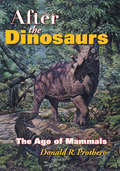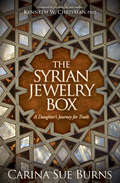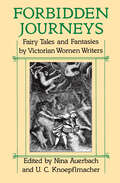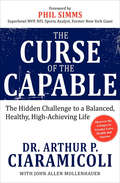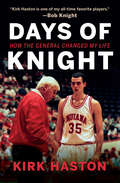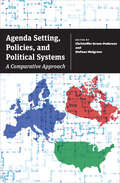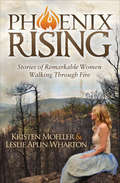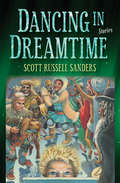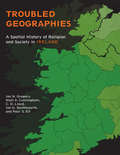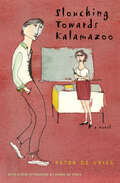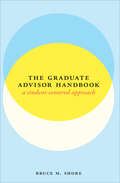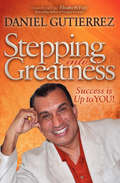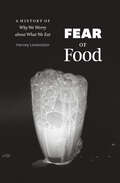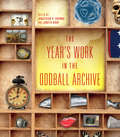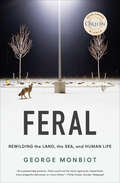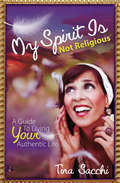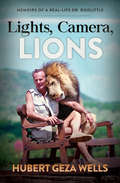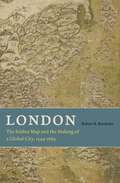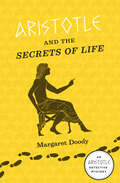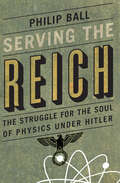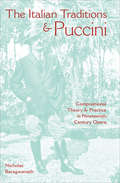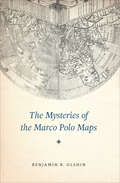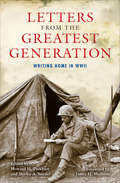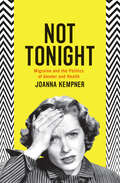- Table View
- List View
After the Dinosaurs: The Age of Mammals (Life Of The Past Ser.)
by Donald R. ProtheroA fascinating study of the thousands of new animal species that walked in the footsteps of the dinosaurs—and the climate changes that brought them forth. The fascinating group of animals called dinosaurs became extinct some 65 million years ago (except for their feathered descendants). In their place evolved an enormous variety of land creatures, especially mammals, which in their way were every bit as remarkable as their Mesozoic cousins. The Age of Mammals, the Cenozoic Era, has never had its Jurassic Park, but it was an amazing time in earth&’s history, populated by a wonderful assortment of bizarre animals. The rapid evolution of thousands of species of mammals brought forth many incredible creatures―including our own ancestors. Their story is part of a larger story of new life emerging from the greenhouse conditions of the Mesozoic, warming up dramatically about 55 million years ago, and then cooling rapidly so that 33 million years ago the glacial ice returned. The earth&’s vegetation went through equally dramatic changes, from tropical jungles in Montana and forests at the poles. Life in the sea underwent striking evolution reflecting global climate change, including the emergence of such creatures as giant sharks, seals, sea lions, dolphins, and whales. Engaging and insightful, After the Dinosaurs is a book for everyone who has an abiding fascination with the remarkable life of the past.
The Syrian Jewelry Box: A Daughter's Journey for Truth
by Carina Sue BurnsAfter she discovers a shocking family secret, Carina takes a journey toward self-acceptance in this &“must-read for anyone who is adopted&” (Richard Krawczyk). A young American growing up in the Middle East, Carina Rourke enjoys a blissful innocence until, at age fifteen, she is captivated by an obsessive desire to look inside her mother&’s forbidden jewelry box. There, Carina discovers a shocking family secret. On the heels of her discovery, she and her family pursue her father&’s dream of a road trip through the Middle East and Europe. Their adventure serves as a metaphoric journey for the woman Carina becomes—a silent nomad searching for identity. When they reach Paris, Carina is entranced by the city&’s temptations. French pastries become a dangerous addiction and an accomplice in silence . . . and so does the love of a mysterious Tunisian. Many years later, as a married mother in Holland, Carina draws on her father&’s wisdom to finally confront the family secret and begin to heal herself and her family. &“Carina&’s book shows you how to become empowered by the sometimes shocking and traumatic experience of adoption.&” —Richard Krawczyk, author of Ultimate Success Blueprint
Forbidden Journeys: Fairy Tales and Fantasies by Victorian Women Writers
by Nina Auerbach and U. C. KnoepflmacherThis &“darkly entertaining&” story collection is &“a significant contribution to nineteenth-century cultural history, and especially feminist studies" (United Press International). In the 1870s and 1880s, children&’s literature saw some astonishingly bold and innovative writing by women authors. As these eleven dark and wild stories demonstrate, fairy tales by Victorian women constitute a distinct literary tradition, one that was startlingly subversive for its time. While writers such as Lewis Carroll and J.M. Barrie wrote nostalgic tales that pined for lost youth, their female counterparts had more serious—at times unsettling—concerns. From Anne Thackeray Ritchie&’s adaptations of "The Sleeping Beauty in the Wood" to Christina Rossetti&’s unsettling anti-fantasies in Speaking Likenesses, the stories collected here are breathtaking acts of imaginative freedom, by turns amusing, charming, and disturbing. Besides their social and historical implications, they are extraordinary works of fiction, full of strange delights for readers of any age."The editors&’ intelligent and fascinating commentary reveals ways in which these stories defied the Victorian patriarchy."—Allyson F. McGill, Belles Lettres
The Curse of the Capable: The Hidden Challenges to a Balanced, Healthy, High-Achieving Life
by John Allen Mollenhauer Dr. Arthur P. CiaramicoliWhy high achievers so often struggle to find true happiness—and how they can learn to balance performance with inner peace. When we look at outwardly successful, capable people, we often presume that they must experience satisfaction with their lives. We can make the same mistake when we view ourselves—wondering why we&’re plagued by anxieties, self-doubt, exhaustion, or even addictions and health problems when it seems like we &“should&” be happy. This insightful book shows how the stories we create about ourselves early in life—stories that can often include some fictional elements—can have a dramatic impact on our current situation. The beliefs and habits we&’ve developed can even lead into a downward spiral, as feelings of being overwhelmed or disappointed start to affect our performance in life, causing a crash in self-esteem. With The Curse of the Capable, you can start to untangle the hidden hardships that plague so-called high achievers—and find the crucial balance between taking care of business and taking care of yourself.
Days of Knight: How the General Changed My Life (Encounters: Explorations in Folklore and Ethnomusicology)
by Kirk Haston&“A personal glimpse into how the legendary Indiana basketball coach taught and mentored his team.&”—Jared Jeffries, former Indiana Hoosier and New York Knick What happens when a 6' 9" kid from Lobelville, Tennessee is recruited by legendary basketball coach Bob Knight? Kirk Haston&’s life was changed forever with just a two-minute phone call. With previously unknown Knight stories, anecdotes, and choice quotes, Haston gives fans an inside look at the notoriously private man and his no-nonsense coaching style. Which past Hoosier basketball greats returned to talk to and practice with current teams? How did Knight mentally challenge his players in practices? How did the players feel when Knight was fired? In this touching and humorous book, Haston shares these answers and more, including his own Hoosier highs—shooting a famous three-point winning shot against number one ranked Michigan State—and lows—losing his mom in a heartbreaking tornado accident. Days of Knight is a book every die-hard IU basketball fan will treasure.
Agenda Setting, Policies, and Political Systems: A Comparative Approach
by Bryan D. Jones Peter John Sylvain Brouard Martial Foucault Éric Montpetit Frédéric Varone Will Jennings Shaun Bevan Isabelle Engeli Pascal Sciarini Anne Hardy Laura Chaqués-Bonafont Anna M. Palau Emiliano Grossman Arco Timmermans Isabelle Guinaudeau Christian Breunig Michelle C. Whyman Gerard Breeman Roy Gava Brandon Zicha Jeroen Joly Tobias Van Assche Enrico Borghetto Marcello Carammia Francesco Zucchini Luz M. Muñoz MarquezWhat will gain the system&’s attention? &“Explores the dynamics of a broad range of policy issues in different countries . . . an important scholarly contribution.&” —Political Studies Review Before making significant policy decisions, political actors and parties must first craft an agenda designed to place certain issues at the center of political attention. The agenda-setting approach in political science holds that the amount of attention devoted by the various actors within a political system to issues like immigration, health care, and the economy can inform our understanding of its basic patterns and processes. While there has been considerable attention to how political systems process issues in the United States, Christoffer Green-Pedersen and Stefaan Walgrave demonstrate the broader applicability of this approach by extending it to other countries and their political systems. This book brings together essays on eleven countries and two broad themes. Contributors to the first section analyze the extent to which party and electoral changes and shifts in the partisan composition of government have led—or not led—to policy changes in the United States, the United Kingdom, the Netherlands, Denmark, Switzerland, and France. The second section turns the focus on changing institutional structures in Germany, Italy, Belgium, Spain, and Canada, including the German reunification and the collapse of the Italian party system. Together, the essays make clear the efficacy of the agenda-setting approach for understanding not only how policies evolve, but also how political systems function.
Phoenix Rising: Stories of Remarkable Women Walking Through Fire
by Kristen Moeller Leslie Alpin WhartonHow do you go on after you&’ve lost everything? True stories of surviving the Colorado wildfires and finding hope for the future. Over several terrifying summers, deadly wildfires raged across Colorado. Lives were lost, and the flames destroyed thousands of homes. When the smoke cleared and only rubble remained, survivors were left trying to find a way forward against devastating loss. The aftermath of that destruction would span many years, and its effects are still felt today. In Phoenix Rising, twenty women share their stories of fire, the terror they felt as flames engulfed their communities, and the dark desperation that followed. And how—in the ensuing weeks and months—they worked to recreate a life from the ashes. Their tales of fear and bravery, of deep compassion and heart-rending grief, offer an uplifting chronicle of human courage and resilience. &“[A] gem of a book . . . When it comes to withstanding and making meaning of the most painful twists of this mysterious life, or enjoying its surprising rewards, nothing compares to the company of other women and their stories.&” —Megan Feldman Bettencourt, author of Triumph of the Heart: Forgiveness in an Unforgiving World
Dancing in Dreamtime (Break Away Book Club Edition)
by Scott Russell SandersThis story collection by the acclaimed author and conservationist &“sparks with brilliant imagery&” in tales of dystopian worlds and human resilience (Teresa Milbrodt, author of Bearded Women: Stories). Fans of Scott Russell Sanders, the Lannan Literary Award-winning essayist and author of The Conservationist Manifesto, may be surprised to learn he was one of the brightest science-fiction newcomers of the 1980s. In Dancing in Dreamtime, Sanders returns to his sci-fi roots, exploring both inner and outer space in a speculative collection of short stories. At a time when humankind faces unprecedented, global-scale challenges from climate change, loss of biodiversity, dwindling vital resources, and widespread wars, this collection of planetary tales will strike a poignant chord with the reader. Sanders has created worlds where death tolls rise due to dream deprivation, where animals only exist in mechanical form, and where people are forced to live in biodomes to escape poisoned air. &“Clear-eyed and philosophical&” these vividly imagined stories combine &“intellectualism with magical realism in an uncommon unity of mind and spirit&” (Shelf Awareness).
Troubled Geographies: A Spatial History of Religion and Society in Ireland (The Spatial Humanities)
by Ian N. Gregory Niall A. Cunningham Ian G. Shuttleworth Paul S. Ell C. D. Lloyd&“Tap[s] the power of new geospatial technologies . . . explore[s] the intersection of geography, religion, politics, and identity in Irish history.&”—International Social Science Review Ireland&’s landscape is marked by fault lines of religious, ethnic, and political identity that have shaped its troubled history. Troubled Geographies maps this history by detailing the patterns of change in Ireland from 16th century attempts to &“plant&” areas of Ireland with loyal English Protestants to defend against threats posed by indigenous Catholics, through the violence of the latter part of the 20th century and the rise of the &“Celtic Tiger.&” The book is concerned with how a geography laid down in the 16th and 17th centuries led to an amalgam based on religious belief, ethnic/national identity, and political conviction that continues to shape the geographies of modern Ireland. Troubled Geographies shows how changes in religious affiliation, identity, and territoriality have impacted Irish society during this period. It explores the response of society in general and religion in particular to major cultural shocks such as the Famine and to long term processes such as urbanization. &“Makes a strong case for a greater consideration of spatial information in historical analysis―a message that is obviously appealing for geographers.&”—Journal of Interdisciplinary History &“A book like this is useful as a reminder of the struggles and the sacrifices of generations of unrest and conflict, albeit that, on a global scale, the Irish troubles are just one of a myriad of disputes, each with their own history and localized geography.&”—Journal of Historical Geography
Slouching Towards Kalamazoo: A Novel (Phoenix Fiction)
by Peter De VriesThe classic American coming of age novel of a precocious young man and the lessons learned from his tutor by &“a masterly entertainer and social satirist&” (The New York Times). It is 1963 in an unnamed town in North Dakota, and Anthony Thrasher is languishing for a second year in eighth grade. Prematurely sophisticated, young Anthony spends too much time reading Joyce, Eliot, and Dylan Thomas but not enough time studying the War of 1812 or obtuse triangles. A tutor is hired, and this "modern Hester Prynne" offers Anthony lessons that ultimately free him from eighth grade and situate her on the cusp of the American sexual revolution. In Slouching Towards Kalamazoo, Peter De Vries finds the perfect vehicle for his eridute wit in Anthony&’s restless adolescent voice. Demonstrating a fascination with both language and female anatomy, Anthony&’s pitch-perfect narration propels this satirical coming of age tale through theological debates and quandaries both dermatological and ethical, while soaring on the De Vriesian hallmark of scrambling conventional wisdom for comic effect.
The Graduate Advisor Handbook: A Student-Centered Approach (Chicago Guides to Academic Life)
by Bruce M. ShoreYou&’re advising students to help ensure their success—but who&’s going to advise you? With university budgets shrinking, graduate advisors find their workloads increasing. A professor emeritus of educational psychology at McGill University with more than forty years of advising experience and several teaching awards, Bruce M. Shore provides a practical guide here that demystifies the advisor-student relationship and helps both parties thrive. Emphasizing the interpersonal relationship at the heart of this important academic partnership, he reveals how advisors can draw on their own strengths to create a rewarding rapport.The Graduate Advisor Handbook moves chronologically through the advising process, from the first knock on the door to the last reference letter. Along the way it covers: transparent communicationeffective motivationcooperative troubleshootingtouchy subjects, including what to do when personal boundaries are crossed and how to deliver difficult news—with sample scripts to help advisors find the right words for even the toughest situations A valuable resource, The Graduate Advisor Handbook has the cool-headed advice and comprehensive coverage that advisors need to make the advising relationship not just effective but also enjoyable.
Stepping into Greatness: Success is Up to You!
by Daniel GutierrezFully realize your gifts and become your greatest self with this &“journey of personal transformation that leads to success beyond wildest dreams&” (Janet Bray Attwood, New York Times–bestselling coauthor of The Passion Test).Stepping into Greatness is about understanding that you are created in the image of greatness, and that is enough. It is about looking deep inside at ourselves and realizing that a lot of the negative things we assume about ourselves just aren&’t true. Accepting your greatness is about self-love, self-acceptance, self-realization, and ending the struggle and doubt with yourself. What we believe and perceive—whether good or bad—is the core of our inner power. Transformation comes from harnessing that power to work for us. It creates our reality, our vision, our purpose, and our ultimate success. To become the &“master of your fate&” you must take responsibility for your choices. Your life, your loves, your passion, your work—all of it can empower you in a way that inspires, encourages, and lets you rise to greater things. Success is just waiting to happen—and all you have to do is take that first step with &“this great book full of common sense that, step-by-step, helps the reader into leadership&” (Don Miguel Ruiz, MD, New York Times–bestselling author of The Four Agreements).
Fear of Food: A History of Why We Worry about What We Eat
by Harvey LevensteinAn &“entertaining and enlightening&” history of the scares, scams, and pseudoscience that have made food a source of anxiety in America (The Boston Globe). Are eggs the perfect protein, or cholesterol bombs? Is red wine good for my heart, or bad for my liver? Will pesticides and processed foods kill me? In this book, food historian Harvey Levenstein encourages us to take a deep breath, and reveals the people and vested interests who have created and exploited so many worries surrounding the subject of what we eat. He tells of the prominent scientists who first warned about deadly germs and poisons, and those who charged that processing foods robs them of life-giving vitamins and minerals. These include Nobel laureate Eli Metchnikoff, who advised that yogurt would enable people to live to 140, and Elmer McCollum, the &“discoverer&” of vitamins, who tailored his warnings about deficiencies to suit the food producers who funded him. He also highlights how companies have taken advantage of these concerns—by marketing their products to the fear of the moment. Fear of Food is a lively look at the food industry and American culture, as well as a much-needed voice of reason; Levenstein expertly questions these stories of constantly changing advice, and helps free us from irrational fears so we can rediscover the joy of eating. &“Guides us through an entertaining series of obsessions—from the outsized fear of flies spreading germs (leading to the 1905 invention of the fly swatter) to a panic about germ-ridden cats infecting human food (which led to a 1912 Chicago public health warning that felines were &‘extremely dangerous to humanity&’)…[a] roster of American food nuttiness.&”—TheBoston Globe &“[Takes] readers through a succession of American fads and panics, from an epidemic of &‘germophobia&’ at the start of the twentieth century to fat phobia at its end. He exposes the instigators of these panics: not only the hucksters and opportunists but also the scientists and health experts.&”—Times Literary Supplement
The Year's Work in the Oddball Archive (The Year's Work: Studies in Fan Culture and Cultural Theory)
by Grant Farred Timothy Sweet Aaron Jaffe Joseph Campana Charles M. Tung Dennis Allen Theodore Bale Atia Sattar Beth A. McCoy Robin Blyn Seth Morton&“By playing with notions of collecting and cataloging, this anthology offers a range of investigations into detritus and forgotten ephemera.&”—Colin Dickey, coeditor of The Morbid Anatomy Anthology The modern age is no stranger to the cabinet of curiosities, the freak show, or a drawer full of odds and ends. These collections of oddities engagingly work against the rationality and order of the conventional archive found in a university, a corporation, or a governmental holding. In form, methodology, and content, The Year&’s Work in the Oddball Archive offers a counterargument to a more reasoned form of storing and recording the avant-garde (or the post-avant-garde), the perverse, the off, the bent, the absurd, the quirky, the weird, and the queer. To do so, it positions itself within the history of mirabilia launched by curiosity cabinets starting in the mid-fifteenth century and continuing to the present day. These archives (or are they counter-archives?) are located in unexpected places—the doorways of Katrina homes, the cavity of a cow, the remnants of extinct animals, an Internet site—and they offer up &“alternate modes of knowing&” to the traditional archive. &“An unruly―and much-needed―model for how to do the archive differently.&”—Scott Herring, author of The Hoarders: Material Deviance in Modern American Culture &“It was a pleasure to read through this collection, and I suspect some of the essays, if not the entire book, will find itself on the syllabus for my Archive and Ephemera graduate course.&”—Museum Anthropology Review &“A finely wrought collection of curiosities . . . A vital intervention into how we talk about the stuff that surrounds us.&”—Colin Dickey, coeditor of The Morbid Anatomy Anthology
Feral: Rewilding the Land, the Sea, and Human Life
by George MonbiotAn optimistic approach to environmentalism that focuses on the wonders of rewilding, not just the terrifying consequences of climate change. To be an environmentalist early in the twenty-first century is always to be defending science and acknowledging the hurdles we face in our efforts to protect wild places and fight climate change. But let&’s be honest: hedging has never inspired anyone. So what if we stopped hedging? What if we grounded our efforts to solve environmental problems in hope instead, and let nature make our case for us? That&’s what George Monbiot does in Feral, a lyrical, unabashedly romantic vision of how, by inviting nature back into our lives, we can simultaneously cure our &“ecological boredom&” and begin repairing centuries of environmental damage. Monbiot takes readers on an enchanting journey around the world to explore ecosystems that have been &“rewilded&”: freed from human intervention and allowed—in some cases for the first time in millennia—to resume their natural ecological processes. We share his awe as he kayaks among dolphins and seabirds off the coast of Wales and wanders the forests of Eastern Europe, where lynx and wolf packs are reclaiming their ancient hunting grounds. Through his eyes, we see environmental success—and begin to envision a future world where humans and nature are no longer in conflict, but are part of a single, healing world.
My Spirit Is Not Religious: A Guide To Living Your Authentic Life
by Tina SacchiA holistic spiritual practitioner shares tips on how to evolve from traditional religious teachings to a spirituality that reflects your true beliefs. Millions of people today experience guilt, shame, anger, anxiety, depression, or similarly disempowering emotions as a result of their indoctrination into organized religion. More individuals are leaving the faith they were born into and identifying themselves as spiritual rather than religious. My Spirit Is Not Religious: A Guide to Living YOUR Authentic Life, will help you eliminate emotional obstacles while providing guidelines for living a heartfelt spiritual life via lessons delivered from personal experiences—Tina Sacchi&’s as well as those of her many clients and students. The intention is not to dismiss all organized religions, but to guide those for whom they no longer work and laying the groundwork for overcoming guilt, shame, loneliness, blame, anxiety, sadness, disappointment, and confusion. Whether you have a background in religion or not, this book will guide you to living YOUR authentic life. &“I highly recommend Tina&’s book to everyone that breathes and thinks. Tina&’s book opened my eyes and my soul to areas I had thought I had clarity around my faith.&” —Wise Women Read
Lights, Camera, Lions: Memoirs of a Real-Life Dr. Doolittle
by Hubert Geza WellsA unique and entertaining memoir of training and working with animal actors. Lights, Camera, Lions tells the remarkable story of Hungarian Hubert Geza Wells, who defects to America during the communist era and goes on to make a name for himself as one of the most sought-after animal trainers in Hollywood. With tales from his long career, which included filming on five continents and working on over a hundred films including Out of Africa and Born Free, his hair-raising memoir (pun intended) also provides insight into training animals that has never been revealed before.
Between Word and Image: Heidegger, Klee, and Gadamer on Gesture and Genesis (Studies in Continental Thought)
by Dennis J. SchmidtA groundbreaking examination of word and image through the lenses of modern art and Continental philosophy: &“Probing and lucid&” (Stephen H. Watson, University of Notre Dame). Engagement with the image has played a decisive role in the formulation of the very idea of philosophy since Plato. Identifying pivotal moments in the history of philosophy, Dennis J. Schmidt develops the question of philosophy&’s regard of the image by considering painting―where the image most clearly calls attention to itself as an image. Focusing on the philosophies of Martin Heidegger and Hans-Georg Gadamer and the art of Paul Klee, Schmidt pursues larger issues in the relationship between word, image, and truth. As he investigates alternative ways of thinking about truth through word and image, Schmidt shows how the form of art can indeed possess the capacity to change its viewers.
London: The Selden Map and the Making of a Global City, 1549–1689
by Robert K. BatchelorA historian recounts the unlikely rise of a world capital, and how its understanding of Asia played a key role. If one had looked for a potential global city in Europe in the 1540s, the most likely candidate would have been Antwerp, which had emerged as the center of the German and Spanish silver exchange as well as the Portuguese spice and Spanish sugar trades. It almost certainly would not have been London, an unassuming hub of the wool and cloth trade with a population of around 75,000, still trying to recover from the onslaught of the Black Plague. But by 1700, London&’s population had reached a staggering 575,000 and it had developed its first global corporations, as well as relationships with non-European societies outside the Mediterranean. What happened in the span of a century and half? And how exactly did London transform itself into a global city? London&’s success, Robert K. Batchelor argues, lies not just with the well-documented rise of Atlantic settlements, markets, and economies. Using his discovery of a network of Chinese merchant shipping routes on John Selden&’s map of China as his jumping-off point, Batchelor reveals how London also flourished because of its many encounters, engagements, and exchanges with East Asian trading cities. Translation plays a key role in Batchelor&’s study—not just of books, manuscripts, and maps, but also of meaning and knowledge across cultures. He demonstrates how translation helped London understand and adapt to global economic conditions. Looking outward at London&’s global negotiations, Batchelor traces the development of its knowledge networks back to a number of foreign sources, and credits particular interactions with England&’s eventual political and economic autonomy from church and King. London offers a much-needed non-Eurocentric history of London, first by bringing to light and then by synthesizing the many external factors and pieces of evidence that contributed to its rise as a global city. It will appeal to students and scholars interested in the cultural politics of translation, the relationship between merchants and sovereigns, and the cultural and historical geography of Britain and Asia.
Aristotle and the Secrets of Life: An Aristotle Detective Novel (The Aristotle Detective Novels #3)
by Margaret DoodyThe great philosopher and his student face pirates, political intrigue, and more in this dark, suspenseful mystery set in ancient Athens. Tensions between the Athenians and the Makedonians—whose leader, Alexander the Great, is one of Aristotle&’s former students—draw the philosopher across the Aegean Sea, accompanied by the devoted Stephanos. Both will have much to learn about survival as they find themselves beset by pirates, uncovering conspiracy, and facing the horrors of war. It will be up to Aristotle to try to shed light on the darkness they are about to encounter—in this novel in the historical series praised as &“unusually authentic&” (Kirkus Reviews) and &“eminently enjoyable&” (Colin Dexter, author of the Inspector Morse Mysteries). Also published as Aristotle and the Mystery of Life
Serving the Reich: The Struggle for the Soul of Physics under Hitler
by Philip BallThis historical analysis of Heisenberg, Planck, Debye, and other German physicists during WWII &“is a stunning cautionary tale, well researched and told&” (Choice). After World War II, most scientists in Germany maintained that they had been apolitical or actively resisted the Nazi regime, but the true story is much more complicated. In Serving the Reich, Philip Ball takes a fresh look at that controversial history, contrasting the career of Peter Debye, director of the Kaiser Wilhelm Institute for Physics in Berlin, with those of two other leading physicists in Germany during the Third Reich: Max Planck, the elder statesman of physics, and Werner Heisenberg, who succeeded Debye as director of the institute when it became focused on the development of nuclear power and weapons. Mixing history, science, and biography, Ball offers a powerful portrait of moral choice and personal responsibility, as scientists navigated &“the grey zone between complicity and resistance.&” Ball&’s account of the different choices these men made shows how there can be no clear-cut answers or judgement of their conduct. Yet he also demonstrates that the German scientific establishment as a whole mounted no serious resistance to the Nazis, and in many ways acted as a willing instrument of the state. Serving the Reich considers what this problematic history can tell us about the relationship between science and politics today. Ultimately, Ball argues, a determination to present science as an abstract inquiry into nature that is &“above politics&” can leave science and scientists dangerously compromised and vulnerable to political manipulation. A CHOICE Outstanding Academic Title Award winner
The Italian Traditions & Puccini: Compositional Theory & Practice in Nineteenth-Century Opera (Musical Meaning And Interpretation Ser.)
by Nicholas Baragwanath&“A major contribution . . . not only to Puccini studies but also to the study of nineteenth-century Italian opera in general.&” —Nineteenth-Century Music Review In this groundbreaking survey of the fundamentals, methods, and formulas that were taught at Italian music conservatories during the 19th Century, Nicholas Baragwanath explores the compositional significance of tradition in Rossini, Bellini, Donizetti, Verdi, Boito, and, most importantly, Puccini. Taking account of some 400 primary sources, Baragwanath explains the varying theories and practices of the period in light of current theoretical and analytical conceptions of this music. The Italian Traditions and Puccini offers a guide to an informed interpretation and appreciation of Italian opera by underscoring the proximity of archaic traditions to the music of Puccini. &“Dense and challenging in its detail and analysis, this work is an important addition to the growing corpus of Puccini studies. . . . Highly recommended.&” —Choice
The Mysteries of the Marco Polo Maps
by Benjamin B. OlshinWhat&’s the truth behind the travels of Marco Polo? &“A fascinating tale about maps, history and exploration.&”—Times Literary Supplement (UK) In the thirteenth century, Italian merchant and explorer Marco Polo traveled from Venice to the far reaches of Asia, a journey he chronicled in a narrative titled Il Milione, later known as The Travels of Marco Polo. While Polo&’s writings would go on to inspire the likes of Christopher Columbus, scholars have long debated their veracity. Some have argued that Polo never even reached China—while others believe that he came as far as the Americas. Now, there&’s new evidence for this historical puzzle: a very curious collection of fourteen little-known maps and related documents said to have belonged to the family of Marco Polo himself. Here, historian of cartography Benjamin B. Olshin offers the first credible book-length analysis of these artifacts, charting their course from obscure origins in the private collection of Italian-American immigrant Marcian Rossi in the 1930s; to investigations of their authenticity by the Library of Congress, J. Edgar Hoover, and the FBI; to the work of the late cartographic scholar Leo Bagrow; to Olshin&’s own efforts to track down and study the Rossi maps, all but one of which are in the possession of Rossi&’s great-grandson. Are the maps forgeries, facsimiles, or modernized copies? Did Marco Polo&’s daughters—whose names appear on several of the artifacts—preserve in them geographic information about Asia first recorded by their father? Or did they inherit maps created by him? Did Marco Polo entrust the maps to an admiral with links to Rossi&’s family line? Or, if the maps have no connection to Marco Polo, who made them, when, and why? Regardless of the maps&’ provenance, this tale takes us on a fascinating journey, offering insights into Italian history, the age of exploration, and the wonders of cartography. &“Olshin&’s book tugs powerfully at the imagination of anybody interested in the Polo story, medieval history, old maps, geographical ideas, European voyages of discovery, and early Chinese legends.&”—The Wall Street Journal
Letters from the Greatest Generation: Writing Home in WWII
by Howard H. Peckham & Shirley A. SnyderA collection of personal letters from overseas that reveal in day-to-day detail what it was like to serve in World War II. Recounting victory and defeat, love and loss, this is a remarkable and frank collection of World War II letters penned by American men and women serving overseas. Here, the hopes and dreams of the greatest generation fill each page, and their voices ring loud and clear. &“It&’s all part of the game but it&’s bloody and rough,&” writes one soldier to his wife. &“Wearing two stripes now and as proud as an old cat with five kittens,&” remarks another. Yet, as many countries rejoiced on V-E Day, this book reveals that soldiers were &“too tired and sad to celebrate.&” Filled with the everyday thoughts of these fighters, the letters are by turns heartbreaking and amusing, revealing and frightening. While visiting a German concentration camp, one man wrote, &“I don&’t like Army life but I&’m glad we are here to stop these atrocities.&” Meanwhile, in another letter a soldier quips, &“I know lice don&’t crawl so I figured they were fleas.&” A fitting tribute to all veterans, this book brings the experience of war—its dramatic horrors, its dreary hardships, its desperate hope for a better future—to vivid life. &“An intimate portrait of the mundane and remarkable, of heroism and terror, of friendship and loss . . . Timely, compelling, and important reading.&”—Matthew L. Basso, author of Men at Work
Not Tonight: Migraine and the Politics of Gender and Health
by Joanna Kempner&“[An] insightful and eloquent account of our evolving understandings of migraine, from a condition of weak-nerved women, to a &‘real&’…disease&” (Elizabeth Mitchell Armstrong Princeton University). Pain. Vomiting. Hours and days spent lying in the dark. Migraine is an extraordinarily common, disabling, and painful disorder that affects over 36 million Americans and costs the US economy at least $32 billion per year. Nevertheless, it is a frequently dismissed, ignored, and delegitimized condition. In Not Tonight, sociologist Joanna Kempner argues that this general dismissal of migraine can be traced back to the gendered social values embedded in the way we talk about, understand, and care for people in pain. The symptoms that accompany headache disorders—like head pain, visual auras, and sensitivity to sound—lack objective markers of distress that can confirm their existence. Therefore, doctors must rely on the perceived moral character of their patients to gauge how serious their complaints are. Kempner shows how this subjective dimension of diagnosis has shaped the history of migraine. In the nineteenth-century, migraine was seen as a disorder of upper-class intellectual men and hysterical women. In the 1940s, the concept of &“migraine personality&” developed, in which women with migraine were described as uptight neurotics who withheld sex. Even today, we see depictions of people with highly sensitive &“migraine brains.&” Not Tonight casts new light on how cultural beliefs about gender, pain, and the distinction between mind and body influence not only whose suffering we legitimate, but which remedies are marketed, how medicine is practiced, and how knowledge about disease is produced.
